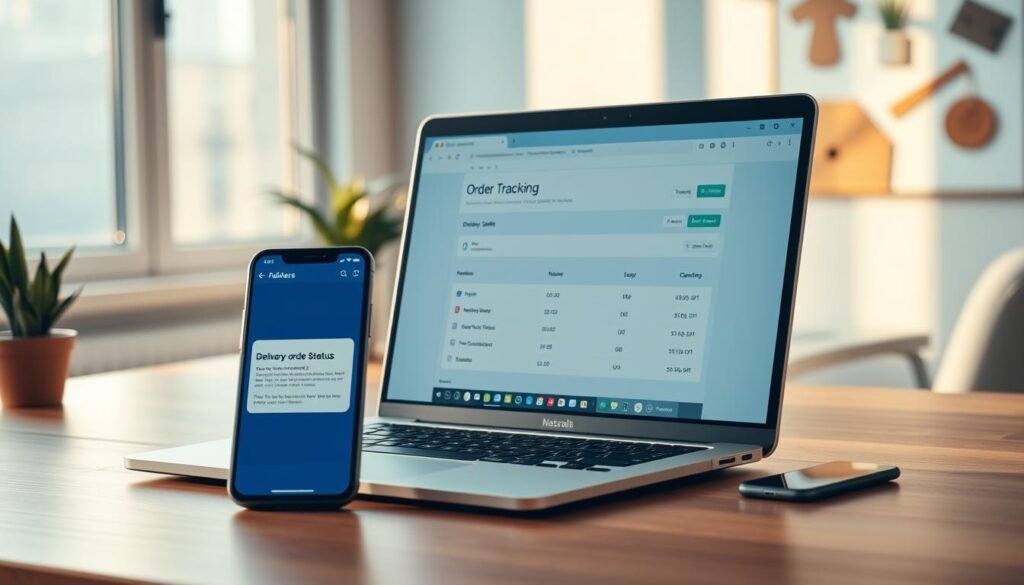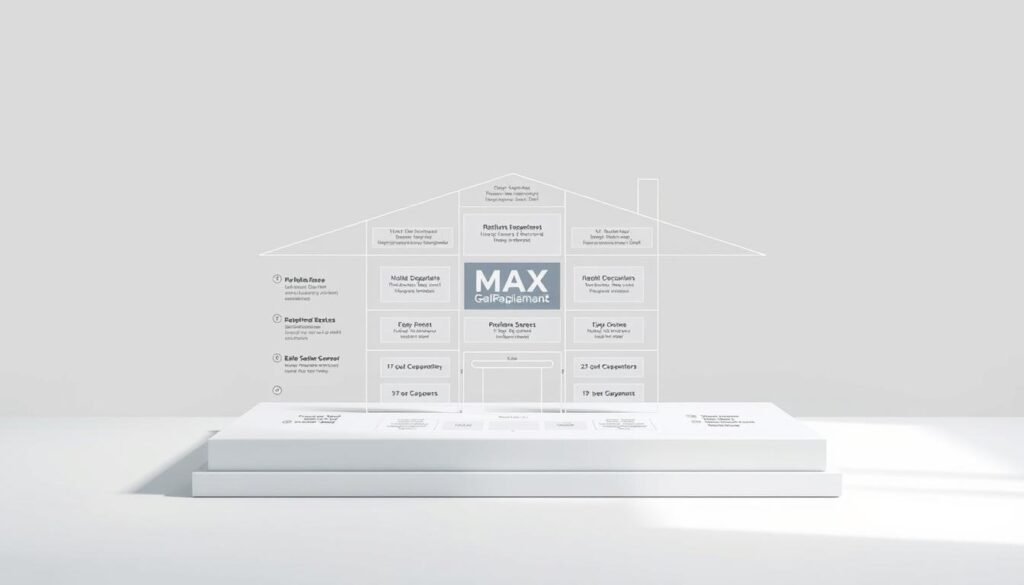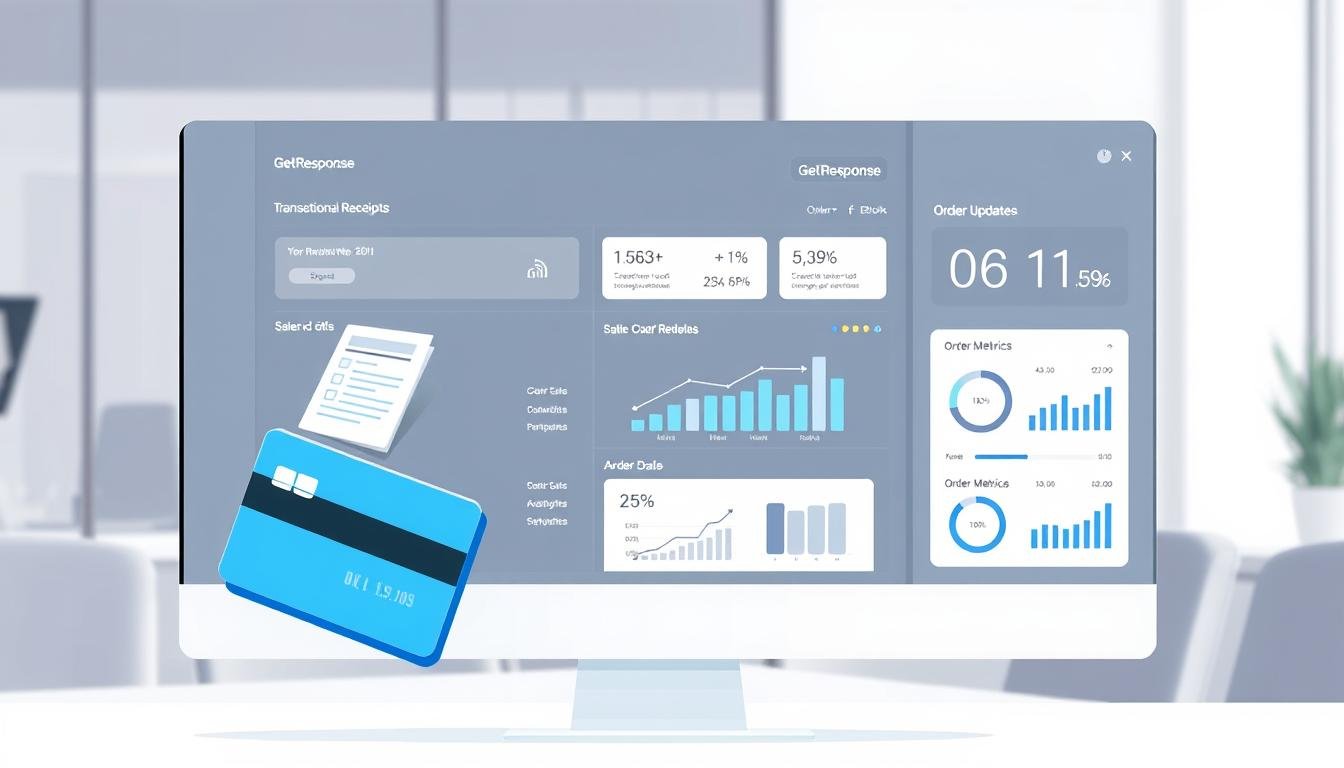This review examines how GetResponse Max streamlines transactional receipts and order updates to boost customer trust, inbox placement, and operational efficiency for high-volume senders.
Transactional email in this product is offered as an add-on for MAX/MAX2 plans with custom pricing, monthly credit resets, and dedicated IPs to protect deliverability. The platform mixes automation, API throughput, and enterprise support so you get immediate confirmations and timely shipping messages that reduce support load.
The guide will clarify why transactional messages differ from promotional email, explain GDPR/CCPA risks when adding marketing content, and preview a practical walkthrough of automation, ecommerce integrations, and observability. You’ll see how the plan’s SLA, support tiers, and pricing match enterprise needs for reliable, mission-critical emails.
Key Takeaways
- MAX tiers add dedicated IPs and higher API limits to safeguard deliverability.
- Keep transactional content free of promotions to stay compliant under GDPR/CCPA.
- Automated confirmations cut support volume and reassure customers quickly.
- Monthly credit resets and custom pricing make the add-on predictable for enterprises.
- MAX2 includes priority support and a Customer Experience Manager for large teams.
- Upcoming sections show setup steps, integrations, and a pricing comparison to competitors.
Overview: Why transactional receipts and order updates matter to your ecommerce customer experience
Clear, prompt confirmations turn a checkout into confidence and cut needless support contacts. A fast confirmation email acts as immediate proof of purchase and sets expectations about delivery.
From proof of purchase to peace of mind:
From proof of purchase to peace of mind: the role of order confirmations
Customers expect confirmation emails within minutes. When you meet that window, you lower anxiety and reduce support volume.
Essential details matter: include order number, items, prices, taxes, shipping address, delivery estimate, and a downloadable invoice.
Turning high-engagement messages into brand and revenue moments
These high-open emails are prime real estate. Keep the core transactional content clear, then add helpful links like tracking, returns policy, and self-serve support.
- Reduce friction: tracking links cut ticket volume.
- Reinforce trust: consistent design and tone improve reviews and lower cancellations.
- Be cautious: light cross-sells can lift sales, but promotional content may change legal classification under GDPR/CCPA.
| Element | Why it matters | Example |
|---|---|---|
| Order number | Proof for support and disputes | Visible at top |
| Delivery estimate | Sets expectations and reduces queries | Include tracking link |
| Invoice | Accounting and returns | Downloadable PDF |
| Brand message | Builds loyalty without harming compliance | River Island, Etsy examples |
What counts as a transactional email in 2025 and why timing is everything
In 2025, a true transactional email is any action-triggered message that completes or documents a user transaction. These messages are sent because a user acted—paid, shipped, or requested a reset—and they must arrive fast.
Core triggers
Key triggers include:
- Order confirmations sent immediately after payment, including a receipt and itemized details.
- Shipping notices with carrier name and tracking number for clear visibility.
- Delivery confirmations with timestamp and a link to support in case of issues.
- Password resets and account-critical alerts that require instant access.
Why speed and accuracy matter
Immediate delivery reduces customer uncertainty and cuts inbound support. When emails contain accurate tracking and relevant details, shoppers feel informed.
Align notifications with fulfillment milestones and carrier scans so messages reflect real-world status. Use observability—logs and dashboards—to spot latency before it becomes a ticket.
| Trigger | Must-have details | Customer benefit |
|---|---|---|
| Order confirmation | Receipt, items, amount, order number | Proof of purchase; lower dispute calls |
| Shipping notice | Carrier, tracking link, estimated arrival | Transparency; fewer tracking requests |
| Delivery confirmation | Timestamp, delivery photo (if available), support link | Closure for customer; reduced follow-ups |
getresponse max transactional receipts and order updates
Enterprise confirmations belong in the platform tier built for scale and reliability. This add-on sits at the MAX/MAX2 level as a custom-priced extension that prioritizes throughput, deliverability, and predictable billing for high-volume merchants.
Where transactional email sits in the product stack
The service is available only as a MAX add-on. Lower tiers do not include this capability, so eligibility requires a MAX quote that bundles pricing for the add-on with enterprise features.
The MAX and MAX2 focus: enterprise-grade automation and support
MAX delivers core enterprise tools: ten users, phone support, SMS credits, webinars for up to 500 attendees, and push notifications to cover lifecycle communications.
MAX2 upgrades support and scale with a dedicated Customer Experience Manager, priority support across channels (chat, email, phone, Slack in special cases), a dedicated IP for stable inbox placement, SSO, enterprise API limits, and unlimited users.
Monthly credit resets make transactional volume predictable for finance and capacity planning. Dedicated IPs and aligned domains further stabilize delivery for confirmations, shipping notices, and other critical emails.
- Designed for mission-critical flows where downtime hits revenue and CX.
- Integration patterns, SLAs, and monitoring focus on fast, consistent delivery.
- When your ecommerce store triggers an event, the platform routes confirmations quickly and reliably.
For details on contact limits and customized pricing tiers, see contact limits and pricing tiers.
Plans, pricing, and eligibility: how MAX and MAX2 unlock transactional emails
Pricing for enterprise confirmations hinges on volume forecasts, API throughput, and deliverability requirements. The service is available only as a MAX-only add-on, provided via a custom quote that reflects your monthly volume and infrastructure needs.
Availability and quoting
Transactional email is reserved for the enterprise tier. You must request a custom proposal. Quotes factor in monthly send volume, peak velocity, and SLA targets.
How pricing works
Volume-based pricing uses monthly credit resets. Unused credits do not roll over, which keeps billing predictable for finance teams.
Deliverability and operational benefits
Dedicated IPs and aligned domains protect sender reputation for essential emails. Enterprise API limits prevent throttling during flash sales or big batches.
- MAX includes a dedicated IP, phone support, SMS credits, and up to 10 users.
- MAX2 adds a dedicated Customer Experience Manager, priority support, SSO, unlimited users, and higher API limits.
- Costs vary with add-ons: SMS, AI features, extra users, and integrations affect the final proposal.
| Need | What to size | Why it matters |
|---|---|---|
| Confirmations & shipping | Monthly sends, peak per minute | Impacts quote and API limits |
| Support flows | Password resets, alerts | Must meet real‑time SLA |
| Compliance | Domain alignment, IPs | Preserves inbox placement |
Before procurement, map email volumes across confirmations, shipping, delivery, and password flows. Draft internal SLAs for time-to-send and inbox placement, then align them with commitments in the contract to capture true value from the platform.
Feature deep dive: automation workflows for receipts, confirmations, and order updates
Visual workflows let you map commerce triggers to precise sends so messages arrive exactly when customers need them.
Visual builder and event triggers
The visual builder maps events—purchase, fulfilled, shipped—to actions that send receipts, status notes, and delivery alerts. Use event-based triggers to reduce latency and avoid manual intervention.
Confirmation, purchase, and abandoned cart automation
Order confirmation automation pulls itemized details, taxes, and delivery estimates from your ecommerce data layer. Purchase automation inserts product specifics and invoices into emails.
Cart reminders use staged messaging: an initial nudge, a follow-up, a final reminder. Respect frequency caps, consent rules, and channel preference to cut friction.
Personalization, promo codes, compliance
Drive revenue with personalized recommendations based on browsing or past purchases, plus synced promo codes tied to unique customers.
Keep the core confirmation strictly transactional. Move marketing content into segmented campaigns or opt-in follow-ups to stay compliant.
Testing, tracking, and segmentation
Version subject lines, test content blocks, then link tracking events back into the workflow for feedback requests or post-delivery outreach. Strong tagging and segmentation keep content relevant and reduce list fatigue.
| Feature | Why it matters | Example |
|---|---|---|
| Visual builder | Faster setup | Drag-drop triggers |
| Abandoned cart | Recover revenue | Timed reminder sequence |
| Personalization | Higher conversion | Product recommendations |
Setup guide: enabling transactional email and integrating your store

Start by wiring your ecommerce platform to the email system so each purchase, payment, and fulfillment event flows without gaps.
Connect Shopify, WooCommerce, Magento, or a custom CMS
Use native connectors or API keys to link Shopify, WooCommerce, or Magento. For a custom CMS, map webhook endpoints to push events into the platform.
Tip: Validate credentials and confirm webhooks fire on create, pay, and ship events before moving on.
Configure data flow: orders, payments, and fulfillment status
Map essential fields: order number, items, taxes, shipping address, payment status, and carrier tracking. Ensure the payload includes timestamps and unique IDs for reconciliation.
Include carrier events so delivery scans trigger status emails with accurate tracking links and delivery ETA.
Template builder basics: receipts, shipping, and delivery notices
Build templates using dynamic fields for order number, item list, totals, and address. Keep the core email focused on transactional details and attach or link a PDF receipt where tax documentation is common.
- Add a clear tracking link, return policy link, and FAQ page to reduce support contacts.
- Restrict promotional content in core emails; move marketing into opt-in workflows.
Testing and observability: sandbox, logs, and A/B for related campaigns
Test in a sandbox with realistic payloads. Use logs to verify timing, error handling, and delivery status.
Run A/B tests only on downstream marketing campaigns—do not alter primary confirmation copy to avoid compliance risks.
| Step | What to verify | Why it matters |
|---|---|---|
| Integration | Webhooks/API latency | Prevents missed sends |
| Template | Dynamic fields populated | Accurate receipts and delivery info |
| Testing | Sandbox logs & error handling | Reduces live failures |
Access control: assign users and role-based permissions so template edits, data mappings, and incident response stay with the right teams.
Deliverability and compliance: GDPR/CCPA nuances, dedicated IPs, and inbox placement
Keep legality and inbox placement tightly linked to how you compose and send confirmations.
When a message documents a purchase or service action, most regulators allow that send without prior consent. Still, if you insert promotional offers or product pitches, the email can be reclassified as marketing and then needs opt-in.
Transactional vs marketing content under GDPR/CCPA
Keep core messages factual. Remove promotions from the primary confirmation to preserve legal status and reduce complaint risk.
- compliance: purely factual confirmations tied to a sale are allowed under contract law.
- compliance: adding cross-sells can trigger marketing rules and consent requirements.
Dedicated IP and domain alignment for consistent delivery
Use dedicated sending IPs and aligned domains from an enterprise plan to stabilize reputation. Authenticate with SPF, DKIM, and DMARC consistently across templates.
Data retention, auditability, and SLA considerations
Document retention periods and preserve message logs for audits and tax records. Define internal SLAs for time-to-send and inbox placement, then match them to your provider’s service commitments.
| Area | Best practice | Why it matters | Action |
|---|---|---|---|
| Authentication | SPF, DKIM, DMARC | Improves inbox placement | Apply across domains |
| Template hygiene | Clean HTML, consistent layout | Reduces spam signals | Standardize blocks |
| Audit logs | Retain sends & tracking events | Regulatory proof and troubleshooting | Archive 1–7 years per policy |
| Security | Mask PII, avoid full payment data | Limits breach risk | Send minimal details |
Ecommerce growth plays inside transactional messages
A well-timed follow-up sequence can turn a single transaction into repeat sales while keeping the confirmation itself clean and compliant.
Keep the original confirmation factual; move promotional activity into consented follow-ups.
Cross-sell and upsell responsibly in follow-ups
Move cross-sell content to post-confirmation campaigns that run after delivery or once consent is confirmed. This preserves legal status and inbox placement.
Use short, precise CTAs that point to a relevant product page or cart. Track lift in average order value and repeat sales to prove value.
Referral nudges, social proof, and content links
Leverage referrals like Cometeer’s model—clear reward for referrer and friend—to boost acquisition without heavy ad spend. Add social proof such as ratings or reviews to reduce remorse.
Include a helpful content link to care guides or how-tos, following Huckberry and Placemkr examples. That content increases product use and lowers support contacts.
- Timing: soft upsell a few days after delivery; care guide within 24–48 hours of receipt.
- CTA alignment: ensure the landing page mirrors intent and reduces friction.
- Measurement: monitor AOV lift, repeat purchase rate, and campaign conversion.
| Tactic | When | Primary KPI |
|---|---|---|
| Referral nudge | Post-delivery | New customers per month |
| Social proof block | Follow-up email | Return rate / NPS |
| Content link (guide) | After delivery | Support tickets reduced |
Comparing GetResponse MAX to other plans and competitors

When enterprise reliability matters, platform choice should prioritize throughput, support, and dedicated sending infrastructure.
MAX vs Ecommerce Marketing: when you need enterprise features
Choose the enterprise tier when uptime, dedicated IPs, and high API limits are non-negotiable.
MAX is the gating option for the transactional email add-on, dedicated IPs, and SLA-backed support. If your business runs mission-critical confirmation flows, this plan offers the governance and throughput large teams require.
How pricing scales versus AWeber, Brevo, HubSpot tiers
For context: Email Marketing starts at $19/1K, Marketing Automation at $59/1K, and Ecommerce Marketing at $119/1K; at 100K contacts those tiers list near $539/$599/$699 respectively. Beyond that range, custom MAX quotes kick in.
| Plan | Strength | When to pick |
|---|---|---|
| Email Marketing ($19/1K) | Cost-effective | Small lists, basic campaigns |
| Marketing Automation ($59/1K) | Advanced automation | Growing businesses with workflows |
| Ecommerce Marketing ($119/1K) | Store integrations | SMB merchants with standard volume |
| MAX / MAX2 (custom) | Dedicated IPs, enterprise API limits, CEM | High-volume, multi-team operations |
AWeber and Brevo can be cheaper at low volume. HubSpot scales differently and bundles CRM tools. Weigh total cost of ownership—SMS, AI features, seats—against improved deliverability, automation, and support. Run a pilot to validate throughput, delivery, and workflow fit before full migration.
Who should choose GetResponse MAX for receipts and order updates
If your business depends on near‑instant confirmations and clear delivery signals, this plan is built for you. It suits teams that need predictable throughput, strict governance, and high inbox placement when tens or hundreds of thousands of emails flow monthly.
High-volume senders, complex workflows, and multi-team operations
Ideal candidates include sellers with >100K contacts, platforms that trigger real-time sends during peaks, and companies that cannot tolerate latency in customer communications.
Use this plan when automation spans purchase, shipping, and post-delivery sequences that require fine-grained segmentation and version control.
Regulated brands and those needing a CEM, SSO, and API scale
MAX2-level features—dedicated customer experience management, single sign‑on, and priority support—help regulated brands meet audit, change‑control, and compliance needs.
Dedicated IPs and domain alignment preserve inbox placement. Enterprise API throughput ensures your triggers fire during holiday spikes without throttling.
| Need | Why it matters | Benefit |
|---|---|---|
| Multi-team access | Governance & roles | Safer edits, fewer mistakes |
| Peak throughput | API limits | Real-time sends under load |
| Regulatory support | CEM & SSO | Simpler audits |
Value breakdown for U.S. brands today
This section quantifies what U.S. brands spend to get reliable post-purchase email into customer inboxes.
Total cost of ownership: plan, add-ons, SMS and compliance
Start with base pricing: Email Marketing begins at $19/1K, Marketing Automation at $59/1K, and Ecommerce Marketing at $119/1K. At 100K contacts those plans list near $539, $599, and $699 respectively.
Enterprise tiers use custom quotes that bundle a plan with the transactional add-on, monthly credit resets, and SMS credits. Factor in dedicated IPs, enterprise API limits, and priority support—these reduce failed sends and speed remediation.
Compliance work costs time: template hygiene to keep confirmations purely factual, plus separate opt-in flows for promotional follow-ups. Nonprofits often qualify for discounts that lower monthly burden.
Time-to-value: from setup to first automated confirmations
With native ecommerce connectors and prebuilt automation templates, most teams can send their first automated confirmations within days.
- ROI drivers: fewer support tickets, higher trust from reliable delivery, and incremental sales from compliant follow-ups.
- U.S. SMS notes: expect brand and campaign registration fees at enterprise scale.
- Set measurable goals: confirmation latency, inbox placement, and post-delivery feedback rates to track early wins.
| Cost element | Why it matters | Typical impact |
|---|---|---|
| Base plan pricing | Monthly license | Predictable billing |
| Add-on credits | Transaction volume | Controls throughput |
| Operational features | IP, APIs, support | Fewer failures; faster fixes |
Conclusion
For high-volume senders, reliable confirmations hinge on predictable infrastructure, clear templates, and strict compliance guardrails.
GetResponse MAX is the enterprise route to dedicated IPs, stronger deliverability, and SLA-backed support for receipts and order updates.
Keep confirmations factual to avoid reclassification under GDPR/CCPA. Move marketing content into consented follow-ups built with automation and tests.
Operational gains are clear: faster notifications, fewer support tickets, higher customer trust, and measurable value. Pricing is custom; transactional credits reset monthly, so align forecasts with the quote.
Next steps: gather volume estimates, map workflows, run a pilot to validate timing and inbox placement, then engage sales for a tailored proposal.

